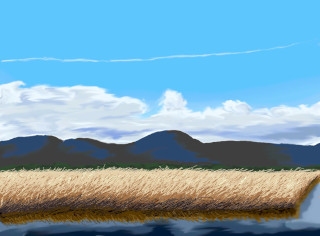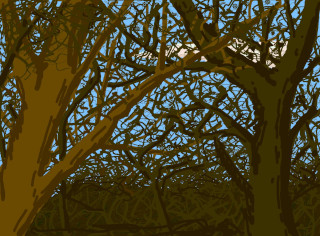Conducted by Bill Kendrick. Posted July 12, 2023.
About Cecilia
- What's your name?
- My name is Cecilia, but I go by korginc (Korg Incorporated) online!
- How old are you?
- I am 20 years old.
- What do you do for a living?
- I am a college student studying history.
- Do you have other artistic endeavors?
- I love to make miniatures using salvaged/found materials.
- What are your other hobbies?
- I play video games, go for long walks, read books, and love to bake!
🖼 View Cecilia's artwork in the Tux Paint Gallery
Discovering and Using Tux Paint
- How and when did you first learn about Tux Paint?
- The first time I used Tux Paint was when my dad downloaded it onto our family computer when I was in the first grade. I had asked him for a “drawing app” like what we used in school, and Tux Paint was the free version he found!
- Did you stop using Tux Paint and come back to it later?
- After a while the family computer died and I forgot about the program. Years later, I made a tweet asking if anyone remembered Tux Paint. To my suprise, Tux themselves responded! I immediately downloaded it on my computer and started creating again.
- How do you usually interact with Tux Paint?
- If I'm on my laptop I use the trackpad, but when im on my PC I used my dad's old tablet and stylus.
- What are your "go-to" tools in Tux Paint?
- I love the stamp tool because I love inserting my own graphics and seeing how the magic tools are able to alter it and make something new, almost like a collage. Particularly I love the emboss, foam, chalk, and the string corners tool, really anything that's going to add texture or depth to my drawing!
- Is there something you wish Tux Paint could do that it can't?
- Sometimes I wish Tux Paint had built in layers, but I think I actually prefer to work with the limitations — it pushes my creativity and thinking! Same with the limitation on the amount of times I can erase. It helps me to work with what I have and not get trapped in a perfection loop.
- What other kinds of art tools do you use?
- Tux Paint is the only digital art tool I use, but I do a lot of physical media art. I love working with “kids” mediums like crayons and crayola markers but I also love life sketching in pen or pencil, or painting with acrylics. I also enjoy making miniatures and for a while was making pottery.
- What tips or tricks would you like to share with other aspiring artists?
- Let the process lead you! When I open Tux Paint, it's rarely because I have an image in my head I want to create — more often I want to immerse myself in the process of creating and experimenting with shapes, color, texture, etc. So I guess my tip is don't get hung up on the final destination, because the learning (and the fun!) is in the journey. There is no creation that is not worthwhile.
- What piece of art, or other creation, are you most proud of?
- There are these two lemons I made as wall decorations for my dorm room. They are cardboard cutouts painted with acrylics and they look spectacular!
Style and Inspiration
- What would you call your art style?
- I wouldn't say I have one specific art style. I love natural realism, that is painting trees and landscapes, still lifes, etc, but I also enjoy making “textures” or non-objective art, especially when I use Tux Paint.
- Are there certain topics or fandoms that you like to focus on in your art?
- Nature, objects, the things immediately in front of and around me. Alternatively, things that are not real and never will be, imagined in my head or created by the artistic process.
- What artists do you look up to?
- So many! First and foremost my Dad (Donato Giancola), who is a sci-fi fantasy illustrator, and the first and biggest supporter of my art (emotionally and materially). Second is a whole host of people, such as Jeremy Miranda, John Singer Sargent, Helma af Klint, Mary Cassatt, Kerry James Marshall, Jeremy Geddes, Charles Burchfield, and more that I am forgetting. I look up to them for their varying commands of light, color, emotion, composition, and story.
- What other things inspire you to make art?
- The people and things around me, and the satisfaction of having sat down and made something or anything.
- Have you ever published or exhibited your art?
- When I was younger my dad would travel to display his art at conventions, and oftentimes I would give him a piece or two of mine to add to his display. And if I remember correctly I even sold a piece once or twice. If that counts!
Bill: That's adorable. And it totally counts. :-)
Wrap-up
- Is there anything I didn't ask you that I should have?
- I want to share that I love collaborating on Tux Paint. I love opening the program and just handing it over to my friend, letting them go crazy and experiment with the medium. They always love it, especially with all the funky sound effects each tool has!
- If you could interview me, or someone else who works on the Tux Paint project, what would you ask us?
- I would love to ask you guys all of the questions you have asked me, and in addition these:
- What is the founding myth or legend of Tux Paint?
- Bill: In 2001 the creator of the typing tutor game Tux Typing (Sam Hart) asked if I could create a math game based on his design and artwork. It was basically the arcade game Missile Command but with math problems, and starring his rendition of Tux, the Linux penguin: Tux, of Math Command. Later, a friend pointed out there weren't any kid-friendly drawing apps for Linux. I decided to take a stab at making one, and borrowed TuxMath's penguin art.
- Who is Tux — the penguin, no doubt, but how did they come to be?
- Bill: Here's what Wikipedia says:
Tux is a penguin character and the official brand character of the Linux kernel. Originally created as an entry to a Linux logo competition, Tux is the most commonly used icon for Linux, although different Linux distributions depict Tux in various styles. The character is used in many other Linux programs and as a general symbol of Linux.
Tux was created by Larry Ewing using the first publicly-released version of GIMP, and named by one James Hughes.
I also used Tux in a Super Mario Bros. clone I started the core of, and a team of people took over (SuperTux) as well as a clone of Defender (Defendguin). - Has the reach of Tux Paint surprised you? The longevity of it?
- Bill: I recently jumped onto social media as "the face of Tux Paint", and what really surprises me is how much genuine joy adults (young and old) get from it. I always expected anyone over the age of 12 wouldn't touch it!
Tux Paint is my magnum opus — I can't imagine any other project being so popular or so long-lasting. I say "my", but I owe my gratitude to dozens of other developers, hundreds of translators, countless teachers and parents who gave it a try and spread the word, and millions of kids — of all ages, apparently — who use it. - What are the things you have created in Tux Paint?
- Bill: I'm not an artist, but I've created a few astronomy drawings that I placed in the gallery, along with Steamed Hams fan art I did for a laugh.
- And finally, would you consider the making of Tux Paint to be a kind of artistic endeavor in itself?
- Bill: I think programming can be a form of artistic expression (not just the form and style of the code, but the results as well), so yes, working on Tux Paint certainly can be!
That said, I also spend a lot of my time doing things which are not particularly artistic: housekeeping the code, website, and documentation, maintaining a social media presence, finding and posting art to the gallery, and now apparently interviewing a bunch of artists! ;-) (I suppose it's kind of like writing or painting — some authors and artists also need to do book signings or exhibits, figure out how to sell their work, interact with fans online, etc.)
Did you know? Tux Paint is not shareware, it's open source. So it's free, forever!




